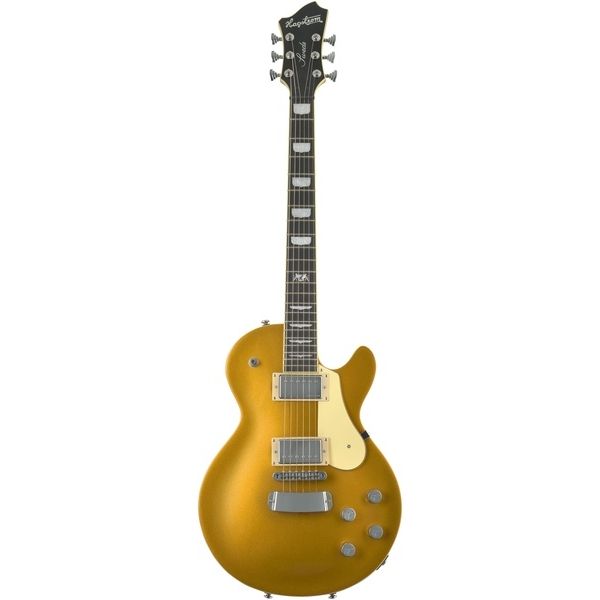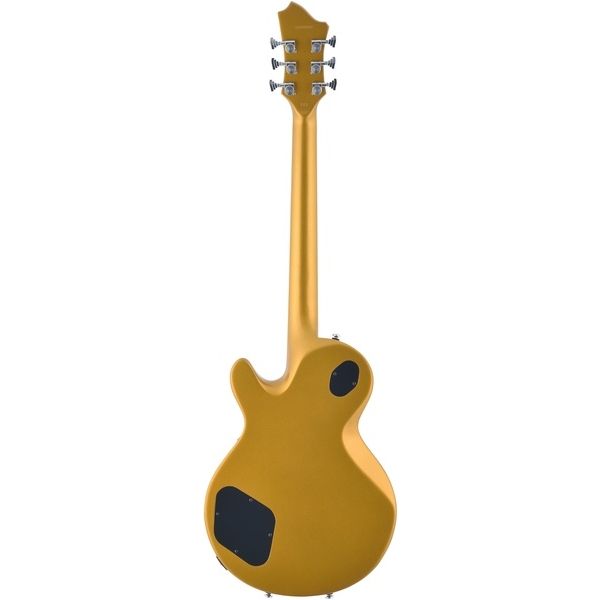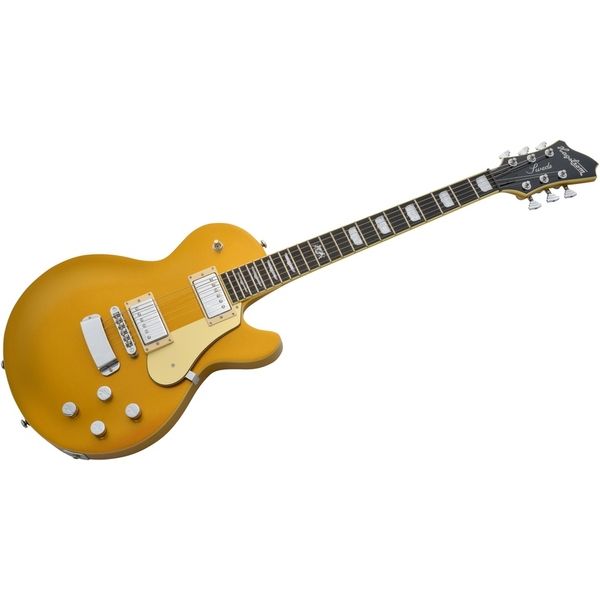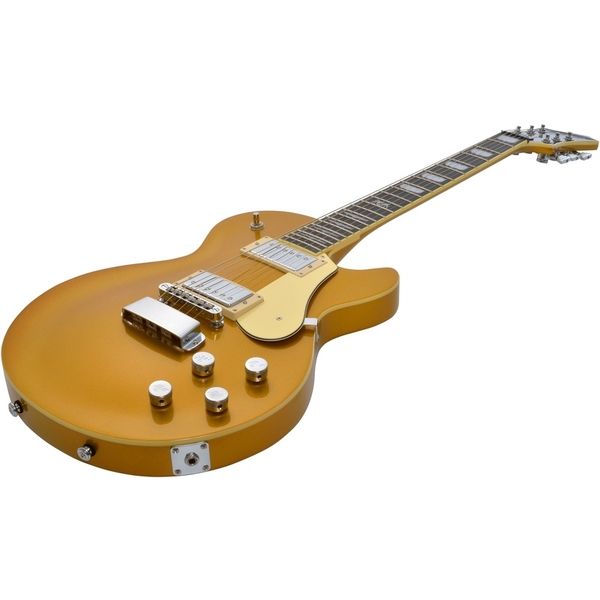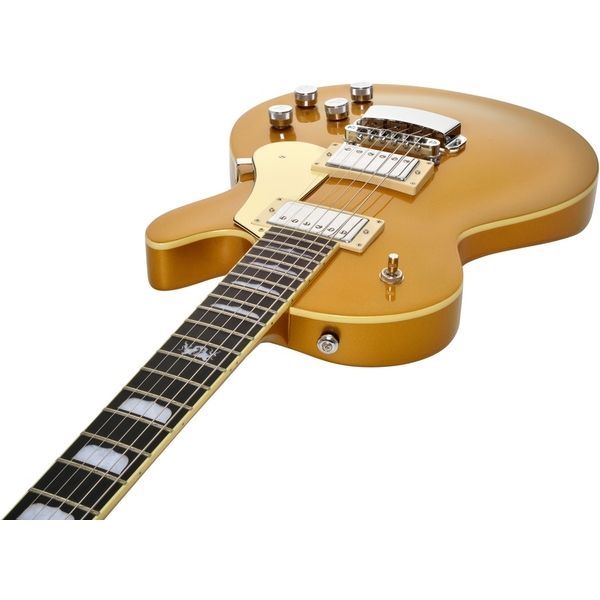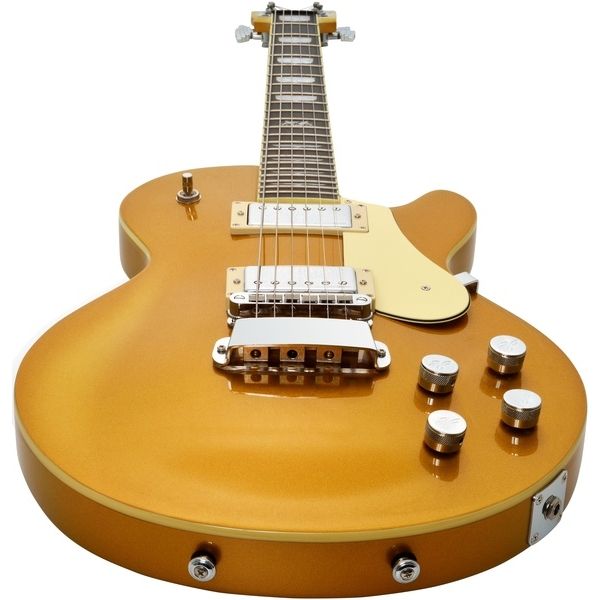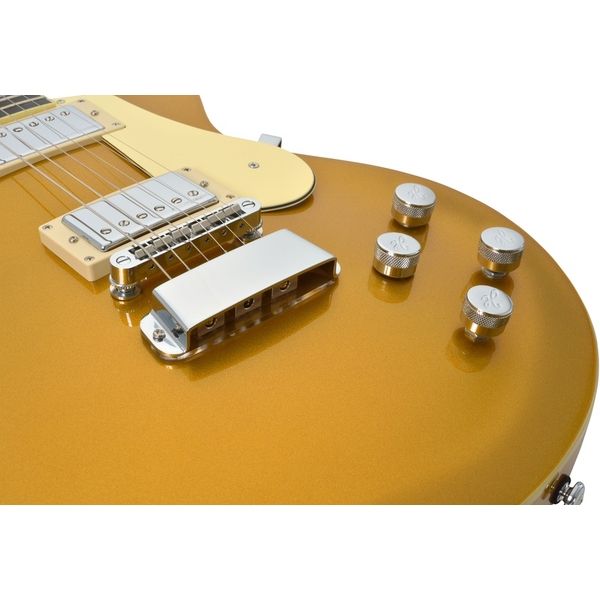Hagstrom Swede Gold
Le caratteristiche della chitarra Hagstrom Swede Gold :
Mahogany body
3/4″ maple top with top-grade flamed maple veneer
Set-in mahogany neck
Resinator fingerboard
Ivoroid Hagstrom « Crest » crest fingerboard inlays with Hagstrom lions at the 12th fret
Neck thickness at 1st fret: 21 mm / 12th fret: 22.5 mm
Scale: 628 mm (24.75″)
Fingerboard radius: 14.4″
Nut width: 43 mm
Graph Tech Black TUSQ XL nut
22 Stainless steel medium jumbo frets
Pickups: 2 split Lundgren Design AlNiCo-2 No. 2 humbuckers
2 x Volume controls with R/C switching
2 x Tone controls with push/pull function for coil split
3-Way toggle switch
Chrome-plated brass Hagstrom « H » barrel knurled pot knobs
Ivory pickguard
Long Travel Tune-O-Matic bridge
Dual Action H-Expander neck tension rod
Hagstrom locking machine heads
Strings: D’Addarío (.010 – .046)
Colour: Gold
Includes C-51 case
In catalogo dal Giugno 2023
Numero di articolo 564442
Unitá incluse 1 Pezzo
Colour Gold
Body Mahogany
Top Maple
Fretboard Resonator Wood
Frets 22
Scale 628 mm
Pickups HH
Tremolo
Incl. Case Yes
Incl. Gigbag No
Le pratiche di fissaggio del corpo della chitarra elettrica (Hagstrom Swede Gold)
Il modo in cui il manico è fissato al corpo della chitarra ha un’influenza significativa sul suono dello strumento musicale. In pratica, ci sono tre principali metodi di connessione al corpo della chitarra:
- manico incollato / set neck
- manico avvitato chiamato bolt-on neck
- manico attraversante (neck-thru)
Il manico avvitato
Inizialmente utilizzato da Fender, questo approccio crea strumenti musicali modulari con parti intercambiabili.
Questo metodo di fissaggio conferisce una certa brillantezza alla chitarra elettrica.
Il manico attraversante (neck-thru)
Tecnica più costosa.
Il manico attraversa la chitarra elettrica ed è parte integrante del corpo. Di conseguenza, offre una diffusione ideale delle vibrazioni.
Il manico incollato o set neck
Questa tipologia di assemblaggio viene realizzata tramite l’uso di un giunto a mortasa e tenone.
Promosso da Gibson, poi dal marchio PRS, ottimizza la sostenibilità (sustain) e il vibrato.
Come scegliere una chitarra elettrica? (Hagstrom Swede Gold)
A causa del suo peso relativamente leggero, la chitarra elettrica è ottimale per tutti i chitarristi.
È adatta a numerosi generi musicali come:
- il blues
- il rock
- la funk
- il jazz
- il metallo
Quale tipo di pickup? (Hagstrom Swede Gold)
Nella scelta di una chitarra elettrica, è consigliabile prestare attenzione ai pickup. I pickup si distinguono in base al loro avvolgimento. È facile distinguere:
- La chitarra elettrica con pickup singolo o doppio.
- La chitarra con pickup singolo è più adatta per il rock, il blues o il country.
- La chitarra elettrica con pickup doppio, come la Gibson, produce un volume di uscita più alto.
Guitar Neck Attributes (Hagstrom Swede Gold)
The size of an electric guitar neck can vary depending on the instrument.
Although the difference may not be significant, it can affect the strings and consequently the melodies.
This has consequences on the melodies.
Guitar Scale Length
The scale length represents the vibrating distance of the strings between the bridge and nut. A shorter scale length will feel more flexible to you. The two most well-known scale lengths are Fender Stratocaster 25.50″ and Gibson 24.75″.
A Shorter Neck
The strings being less tense and more flexible, playing becomes more comfortable, as is the case with Les Paul guitars.
A Longer Scale Length
If the guitar neck is larger, like that of an Ibanez or a Stratocaster, the string tension increases and their vibration also increases.
Electric Guitar Woods (Hagstrom Swede Gold)
The woods chosen by professional luthiers determine the resonance and sound of the electric guitar.
As for the neck, the most common woods on the market are maple and mahogany.
Regarding the fingerboard, traditionally we find:
- rosewood
- maple
- ebony
The change in wood can easily change the sound.
Here are two of the most common woods:
Mahogany
It offers a deep, round sound with strong sustain to the guitar.
Rosewood
A dark wood with good density and hardness, used for making fingerboards.
The Number of Strings for Electric Guitar? (Hagstrom Swede Gold)
Often, electric guitar strings are made of steel or nickel.
Guitarists play using a pick to avoid hurting their hands.
The 12-string Electric Guitar
The 12-string electric guitar is often used by folk music groups in the 1960s. This 12-string electric guitar has the same tuning as a 6-string guitar, but all strings are doubled.
The 6-string Guitar
This 6-string electric guitar has three bass strings and three treble strings.
7-string Electric Guitar
This 7-string electric guitar is a type of guitar for metal players. Moreover, there are several models of jazz guitars in the same style.
The strings of these models are similar to those of the 6-string electric guitar. But they have an additional string that produces a lower note.
Electric Guitar Bodies (Hagstrom Swede Gold)
The type of resonant body has an impact on the sound of the guitar.
Semi-Hollow Body
It combines the advantages of both solid and hollow bodies.
Therefore, it is ideal for playing with a small amplifier.
Hollow Body
The hollow body is particularly used for jazz music.
This type of body offers optimal sound for electro-acoustic and acoustic guitars.
It is ideal for beginner guitarists.
The sound resonates more.
Solid Body
The very first solid body guitar, called Solid Body, was created in 1950. It is easy to handle due to its slim body.
This style of guitar is especially popular for rock music.


